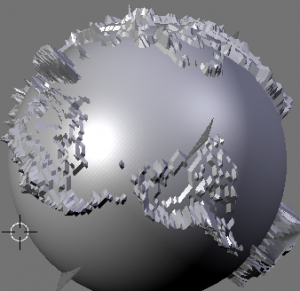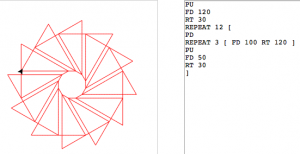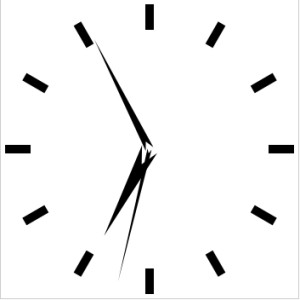So we had our first Craft Night this week in the new space. We moved in Saturday. So in less than a week you can see how far we have come. I am pretty excited about what we’re going to be able to do.
March Madness 4 – Crude Logo Interpreter
Two programs for you for Thursday night’s entry. A crude Logo interpreter written in Javascript using the HTML5 canvas tag and a quick logo program to go with it. Now when I say crude, I mean crude.
- You have to separate everything with whitespace because the parser is finicky.
- All the loops are unrolled so careful with your nesting depth.
- The only commands supported are the basics: FD, LT, RT, PU, PD and REPEAT.
That said you can still make some fun stuff with it. Source is in the “Read more”.
March Madness: Spherify!
I can’t just sit on the sidelines glowering at all the happy coders all month. Here’s my first code snippet for the month: spherify!

It’s a simple little python script that uses an image file as a heightmap, maps it on to a sphere, and spits out an STL file. It can be charitably described as “crude”. Usage:
Usage: spherify.py [options] source
Options:
-h, --help show this help message and exit
-o OUTPATH, --output=OUTPATH
output to given path
-r RADIUS, --radius=RADIUS
radius of lowest point in mm
--height=HEIGHT additional radius of highest point in mm
You’ll need to have the python imaging library installed to use it. Source after the break.
Continue reading »
March Madness Day 3
Under the wire… with a rather boring script. Here’s an apache log parser that uploads log data to MySQL. Interesting part about it? If your user auth field has LDAP data this will parse that properly.
Click through for code…
Continue reading »
 Robert Carlson bridges both the NYC Resistor and DIYBio worlds – he’s an electrical engineer who turns E. coli into circuits! He famously discovered the Carlson curves, the biotech equivalent of Moore’s Law. They show that biotech is advancing at a pace consistent with digital tech.
Robert Carlson bridges both the NYC Resistor and DIYBio worlds – he’s an electrical engineer who turns E. coli into circuits! He famously discovered the Carlson curves, the biotech equivalent of Moore’s Law. They show that biotech is advancing at a pace consistent with digital tech.
Come join us at the NEW NYC Resistor space for an afternoon talk by Rob and discussion afterwards.
DATE: Saturday, March 13
TIME: 2:00pm – 4:00pm
LOCATION: NYCR
Here’s a video of Robert from the Economist that appeared on the DIYBio blog recently: http://diybio.org/2010/01/01/rob-carlson-discusses-diybio-and-open-source-biology-on-the-economist. And an excerpt from his Wired article where he wrote about the emergence of DIYBiology in 2005:
The era of garage biology is upon us. Want to participate? Take a moment to buy yourself a molecular biology lab on eBay. A mere $1,000 will get you a set of precision pipettors for handling liquids and an electrophoresis rig for analyzing DNA. Side trips to sites like BestUse and LabX (two of my favorites) may be required to round out your purchases with graduated cylinders or a PCR thermocycler for amplifying DNA. If you can’t afford a particular gizmo, just wait six months – the supply of used laboratory gear only gets better with time. Links to sought-after reagents and protocols can be found at DNAHack. And, of course, Google is no end of help.
Still, don’t expect to cure cancer right away, surprise your loved ones with a stylish new feather goatee, or crank out a devilish frankenbug. (Instant bioterrorism is likely beyond your reach, too.) The goodies you buy online require practice to use properly. The necessary skills may be acquired through trial and error, studying online curricula, or taking a lab course at a community college. Although there are cookbook recipes for procedures to purify DNA or insert it into a bacterium, bench biology is not easy; the many molecular manipulations required to play with genes demand real skills.
March Madness 3.2: Analog Clock
Here’s a quick analog clock using the HTML5 canvas tag. Oh canvas tag, how I love thee. Click “Read more” for the source. The formatting is a little wonky because I adjusted to fit in the blog. Oh and you can find all my March Madness programs at this page.
March Madness Day 3 – Hardware is fun!
So as not to leave my fellow hardware engineers unrepresented, I present my entry for day 3 of March Madness:
The following code implements (poorly, no doubt) the 64-bit floating point reciprocal approximation unit from the Cray-1 (in Verilog 2001). Warning, not for the faint of heart =)
March Madness Day 2.2
Here’s a couple more additions for the March Madness Challenge. First, a image lens program using the HTML5 canvas tag. Next an OpenSCAD program to make beach rover wheels.
March Madness! Day 2.
So today I decided to mix things up a bit. I figure, how else can one honor the time honored world of languages than by paying homage to the language wrought by Knuth himself…. LaTeX.
Here’s the resulting PDF: m2
I will post the associated EPS file later, currently NYCR’s blog is very anti EPS.
March Madness – Doorknob.scad
So, the March Madness 1 program a day challenge is in full swing. Here’s my contribution. Its not much in the way of code, but there definitely was coding involved in writing the scad file for the doorknob. Yup, its a programmatically generated and then 3D printed doorknob for the NYC Resistor front door. Made with OpenSCAD, QCad, and my MakerBot. Oh, its open source too and you can download it from Thingiverse.



